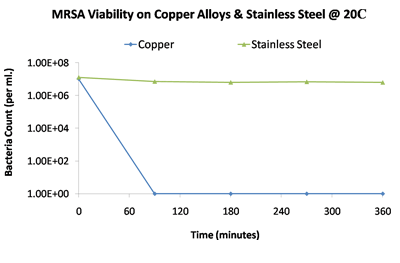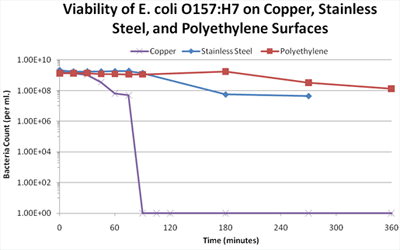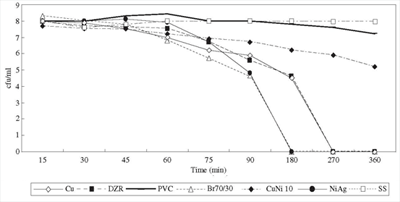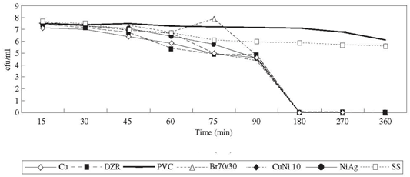Bacteria
Methicillin-resistant Staphylococcus aureus (MRSA)
MRSA infections are an increasing concern in healthcare facilities worldwide. Multi-drug resistant strains of this bacterium are easily transferred from patients and healthcare workers to touched surfaces and vice versa. Copper and copper alloys proactively defend against MRSA. Copper is an excellent material for frequently touched surfaces because of its ability to kill MRSA quickly and effectively. MRSA deposits cannot build up on copper surfaces, and therefore the risk of contaminating a clean room is reduced. The graph below illustrates the survival of MRSA on several copper alloys and stainless steel for comparison. As mentioned above, many copper alloys can legally claim a 99.9% kill of MRSA within two hours.
The data clearly illustrate that stainless steel has virtually no effect on MRSA after 360 minutes.

Escherichia coli O157:H7
This bacterium has been responsible for numerous food recalls, illnesses and deaths. Exposure can cause severe stomach cramps, vomiting and kidney failure. E. coli O157:H7 is spread by contact with infected fecal matter, which happens quite regularly. According to the Centers for Disease Control, everyone has some risk of infection from this bacterium. A surface that kills E. coli O157:H7 could possibly prevent additional contamination of touched surfaces. The data below demonstrates that copper alloy (C110) actively kills E. coli O157:H7 while stainless steel and polyethylene, a common plastic, have virtually no effect after 360 minutes. As acknowledged by the U.S. EPA, 275 copper alloys kill 99.9% of E. coli O157:H7 within two hours.

Pseudomonas aeruginosa
This bacterium, as are many others commonly associated with hospital-acquired infections, is opportunistic. This implies that the bacteria may come into contact with people on a regular basis with no adverse effects. However, when a weakness in the host's defenses is recognized, the bacterium can be deadly. Pseudomonas aeruginosa is found in the soil and on plants and animals. People that come into contact with these mediums can spread the bacteria to touched surfaces which can endanger those with weakened immune systems. This is highly pertinent to patients in a hospital setting. Pseudomonas aeruginosa is responsible for about 0.4% of all hospital-acquired infections each year according to the Centers for Disease Control. Copper surfaces effectively kill this pathogen while other surface materials are relatively inert. U.S. EPA tests confirmed that 275 copper-containing alloys kill 99.9% of Pseudomonas aeruginos within two hours. The chart below shows that copper and several copper alloys kill Pseudomonas aeruginosa within 270 minutes while stainless steel and PVC have almost no effect.
 Mehtar et al.
Mehtar et al.Acinetobacter baumannii
Another opportunistic bacterium, Acinetobacter baumannii, attacks weakened defense systems and exploits ideal conditions. This bacterium has developed very strong resistances to numerous antibiotics and has caused many infections in wounded soldiers stationed in Iraq. An increase in Acinetobacter baumannii-related infections has been observed in community hospitals over the past several years. Data collected by Mehtar et al shows that various copper alloys kill Acinetobacter baumannii in three hours while little or no effect is observed on stainless steel and PVC surfaces.
 Mehtar et al.
Mehtar et al.Clostridium difficile
Commonly known as "C. diff," this gram positive bacteria can cause severe infections of the colon. C. diff naturally resides in the body, but only poses a risk when the natural chemistry of the digestive tract is disrupted. The omnipresent bacteria in the body can be disrupted when a patient is treated with antibiotics. This allows the bacteria to multiply and leaves the patient susceptible to a C. diff infection. The chart below illustrates that a number of copper-containing alloys kill C. diff in hours while the bacteria thrive on stainless steel for days.
 Keevil et al.
Keevil et al.